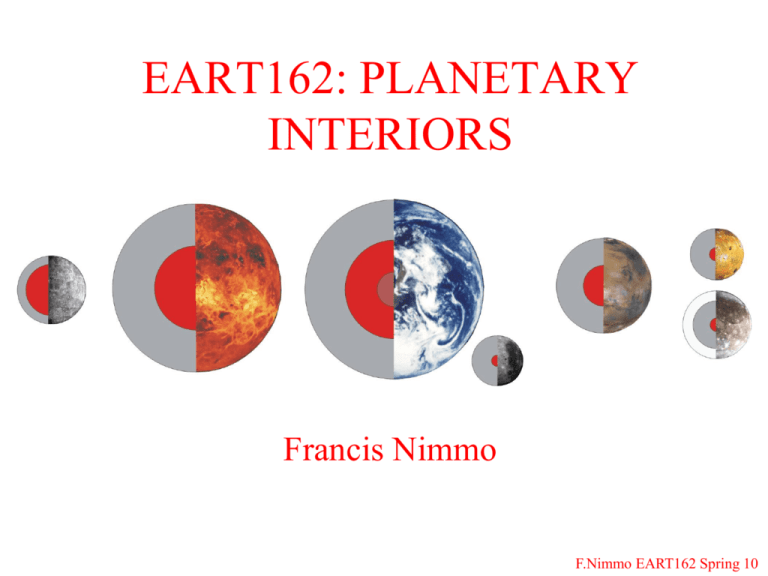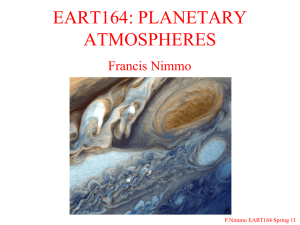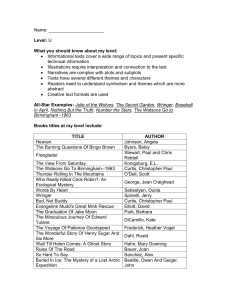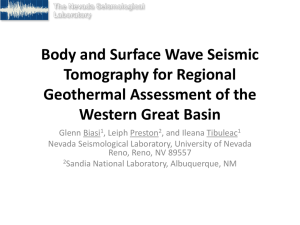Powerpoint slides - Earth & Planetary Sciences
advertisement

EART162: PLANETARY INTERIORS Francis Nimmo F.Nimmo EART162 Spring 10 Last Week – Heat Conduction • Everything you need to know about heat conduction in one equation: d2=kt • Heat transport across mechanical boundary layer is usually by conduction alone • Heat is often transported within planetary interiors by convection (next week) • Main source of heat in silicate planets is radioactive decay • Tidal heating can be an important source of heat in bodies orbiting giant planets F.Nimmo EART162 Spring 10 This Week – Seismology • Not covered in T&S • Useful textbook is Lowrie, Fundamentals of Geophysics, C.U.P., 1997 • Most useful for the Earth; limited applications elsewhere • Only a very brief treatment here – dealt with in much more detail in other courses F.Nimmo EART162 Spring 10 Key Points • Seismic waves are just another kind of elastic response to a load, but they are time-dependent rather than static • Seismic waves have frequencies ~1 Hz • At these (short) periods, the mantle behaves as an elastic solid (it behaves as a viscous fluid over ~Myr timescales) • Two kinds of waves (P,S) with different velocities – only one kind (P) in fluids • Velocities depend on material properties (K,G) F.Nimmo EART162 Spring 10 Refresher on Elasticity • Elasticity: xx E xx xy 2G xy E G 2(1 v) dP E K d 3(1 2v) F.Nimmo EART162 Spring 10 Seismology • Some kinds of waves can propagate in fluids (e.g. sound) • Elastic media allow several different kinds of waves • Seismology is the study of wave propagation through planets • We can derive the wave equation as follows: x xy w y y xy y y Consider only shear stresses for the moment Net shear force / volume in x-direction = xy y xy We can use F=ma to relate the force to the displacement w: a ma V t V w t xy y F.Nimmo EART162 Spring 10 Wave Equation • Recall the definition of the shear modulus: xy 2G xy • We can also relate the strain xy to the displacement w: xy 1 w 2 y • Putting all this together, we get the wave equation (here for shear waves): w w G t t y y • What is the solution to this equation? a w( y , t ) sin[ k (ct y )] c G / k 2 / F.Nimmo EART162 Spring 10 y Wave Equation (cont’d) w( y , t ) sin[ k (ct y )] c G / =2/k Propagation direction, velocity c Shear direction Particle displacement w • Wave (phase) velocity is given by c • Propagation direction is perpendicular to particle motion (and shear) • This kind of wave is known as a transverse, shear or S-waves • Propagation velocity c depends on shear modulus G and density only • In fluids, G is zero so S-waves do not propagate through these materials x F.Nimmo EART162 Spring 10 Longitudinal or P-waves • Here the propagation direction is parallel to particle motion Particle motion C stands for compressional, R for rarefaction stresses C R C RCR CR Propagation direction • In a 2D situation, stresses will arise in a direction perpendicular to the propagation direction (this must occur if perpendicular strain is to be prevented) • So we have to take into account both the shear modulus G and the bulk modulus K • It turns out (see Lowrie) that the P-wave velocity is c K 43 G NB Unlike S-waves, P-waves can propagate through a fluid F.Nimmo EART162 Spring 10 Summary • S waves (transverse) • P waves (longitudinal) Vs G Vp K 43 G • Which kind is faster? • Which kind travels through fluids? • What happens to velocity if density increases? • The most important point is that seismic velocities depend on material properties; thus, by inferring seismic velocities, the material properties can be deduced • We will see in a minute how we can infer velocities F.Nimmo EART162 Spring 10 P- and S-waves • Typical mid-mantle values: K=400 GPa, G=200 GPa, =4800 kg m-3 Vs=6.5 km/s, Vp=12 km/s • S-waves and P-waves produced by the same earthquake will arrive at different times – P waves arrive first (Primary), S waves arrive second • The time difference Dt gives the distance L to the earthquake L L a Vp Dt Vs F.Nimmo EART162 Spring 10 Frequency and Wavelength • Frequency and wavelength are related: v f v=velocity, f=frequency, =wavelength • Seismic events tend to contain a large number of different frequencies • Seismic noise is worst in range 0.1-1 Hz • Attenuation means that high-frequency components are smaller at greater distances from the earthquake • Bigger earthquakes tend to have amplitude peak at longer periods (why?) • Wavelength is important because it determines the smallest object which can be detected • E.g. what is the wavelength of an S-wave at 0.1 Hz? F.Nimmo EART162 Spring 10 Other kinds of waves . . . • The Earth’s surface allows other kinds of waves (surface waves) to propagate • They arrive later than P and S waves • They are generally most sensitive to shallow structures Rayleigh wave Love wave F.Nimmo EART162 Spring 10 What affects seismic velocity? Vs • • • • G Vp K 43 G Temperature – T K,G > so Vp,Vs Pressure – P K,G > so Vp,Vs Composition - e.g. Fe so Vp,Vs Melt – melt fraction G so Vp,Vs (recall that fluids do not support shear) So by measuring vertical or lateral variations in Vp and Vs, we can make inferences about properties such as melt fraction, mineralogy etc. Examples: low velocity zone beneath plates or near plumes (why?), increase in velocity at 670 km depth etc. F.Nimmo EART162 Spring 10 Travel-time curves • A global network of seismometers allows travel-time curves to be constructed (why was it built?) • It turns out we can calculate the radial variation of semisic velocity from the slope of a travel-time curve (t/D) This diagram shows travel-time curves assembled from lots of different earthquakes. The slopes of the curves can be used to obtain the velocity structure of the interior. The technique does not work in low-velocity zones. See Lowrie for more information. t D F.Nimmo EART162 Spring 10 Travel-time curves (cont’d) Shadow zone • We can also use travel-time curves to infer other details e.g. existence of a shadow zone implies a low velocity layer (the outer core). Why is this layer low velocity? F.Nimmo EART162 Spring 10 Adams-Williamson Equation • Given enough data, we can establish how Vp and Vs vary with radial distance • More usefully, we can use Vp and Vs to get density: Density Bulk modulus • Define the seismic parameter V V 2 p 4 3 2 s K The second equality arises because of how Vp and Vs depend on K and • Recall from Week 3 the definition of bulk modulus dP K d • This gives us the Adams-Williamson equation: d ( r ) (r) g (r) a Why is this useful? dr ( r ) F.Nimmo EART162 Spring 10 Adams-Williamson cont’d • • • • • d ( r ) (r) g (r) dr ( r ) The equation is useful because we know r (from the seismic velocity observations) So we can assume a surface density and gravity and then iteratively calculate (r) at successively greater depths using our observations of (r) The approach has to be modified slightly if temperature changes or compositional changes are present Note that the resulting density profile must also satisfy the mass and MoI constraints Bottom line: Vp and Vs, via , gives us the density profile F.Nimmo EART162 Spring 10 Results • Note what happens to Vp and Vs in the outer core • Why do Vp and Vs increase with depth even though density is also increasing? F.Nimmo EART162 Spring 10 Attenuation • Non-elastic effects (friction, viscosity . . .) dissipate energy • We measure this dissipation using the quality factor Q 2E 2 (Energy stored in wave) Q= Energy lost per cycle dE dt • • • • Here E is energy and is wave period Q is the number of cycles it takes to attenuate the wave Note that high Q means low dissipation! Equation above gives us a E E0 exp( 2t Q ) • Energy is reduced to 1/e after Q/2 cycles • What’s an every day example of this effect? F.Nimmo EART162 Spring 10 Attenuation (cont’d) • Remember high Q = low dissipation • What affects Q? • Typical values: Earth 102 (lower in back-arcs – why?) Moon 104 (why so high?) Earth, D=183 km (earthquake) •Q is typically frequency-dependent (why?) •Makes it hard to interpret lunar seismograms! Moon, D=147 km (Saturn booster impact)F.Nimmo EART162 Spring 10 Lunar Seismology (1) • Apollo astronauts deployed four seismometers which collected 8 years of data (they were then switched off to save money – aaargh!) • Three sources of seismic signals: – “Controlled source” – Meteorite impacts – Moonquakes – tidally-triggered, deep • The moonquakes repeat each month and have same waveform each time – presumably same fault is moving • Lunar seismograms hard to interpret because scattering (and high Q) makes first arrivals difficult to identify F.Nimmo EART162 Spring 10 Lunar Seismology (2) • Enough data to establish crude velocity structure for upper mantle of Moon • Lower mantle and core cannot be imaged, mainly because there are no seismic stations on far side • Velocities place some constraints on bulk lunar composition / mineralogy • There is a new international initiative to put more et al. LPSC 2005 seismometers on the Moon P-wave velocity, Johnson F.Nimmo EART162 Spring 10 Martian Seismology • The Viking landers both carried seismometers • But they were not properly coupled to the ground, so all they detected was wind (!) • Since then, no seismometers have been landed (why not?) • The US-French Netlander seismology mission was cancelled due to political factors . . . F.Nimmo EART162 Spring 10 Summary • Seismic velocities tell us about interior properties Vs G Vp K 43 G • Adams-Williamson equation allows us to relate density directly to seismic velocities d (r ) (r ) g (r ) 2 4 2 dr V p 3 Vs • Travel-time curves can be used to infer seismic velocities as a function of depth • Midterm on Thursday – BRING A CALCULATOR! F.Nimmo EART162 Spring 10 Supplementary Material follows NEED TO MENTION SNELL’S LAW? F.Nimmo EART162 Spring 10 Refraction • At a far enough distance from the source of the seismic waves (an earthquake or explosion), we can treat their propagation by ray theory • Snell’s law governs the ray refraction due to a velocity change i1 v1 f1 a r1 v2 i2 f2 r2 i v1 f v2 v1 sin i v2 sin f r1 r2 • On a sphere sin i2 sin f1 • Using Snell’s law, we get r1 sin i1 r2 sin i2 const . v1 v2 F.Nimmo EART162 Spring 10 Ray Parameter r sin i p v • Here p is the ray parameter and describes the trajectory of an individual ray as a function of r and v • How deeply can a particular ray penetrate? • What use is the ray parameter? It allows us to calculate seismic velocity as a function of radius: Path difference = Vt=R sin i D i D D i R R sin i t This gives us p V D Here V is surface velocity F.Nimmo EART162 Spring 10 Travel-time curves R sin i t p V D • We calculate the ray parameter, and thus how v varies with r, from the slope of a travel-time curve (t/D) t D This diagram shows travel-time curves assembled from lots of different earthquakes. The slopes of the curves can be used to obtain the different ray parameters and thus the velocity structure of the interior. The technique does not work in low-velocity zones. See Lowrie for more information. F.Nimmo EART162 Spring 10 F.Nimmo EART162 Spring 10 Normal Modes • A big enough earthquake (Alaska 1964, Indonesia 2005) will set the whole Earth “ringing” like a bell – normal modes (also called free oscillations) • The period (and amplitude) of the different modes depend on the density and elasticity of the Earth • Different modes sample different depths – high frequency modes only sample shallow F.Nimmo EART162 Spring 10 Normal modes (cont’d) • Identification of periods of different modes allow density and velocity structure of Earth to be inferred (independent of P and S wave observations) • Damping of oscillations gives information on Q • Where else might normal modes be useful? Spectrum of normal modes from two stations, following Chile 1960 earthquake. Top line measures the degree of agreement between the two stations. From Stacey, Physics of the Earth. F.Nimmo EART162 Spring 10









